|
|
Iglesia de Santa María Magdalena (Jerusalén)
De Wikipedia, la enciclopedia libre
La iglesia de Santa María Magdalena (en ruso: Храм Марии Магдалины, Khram Marii Magdaline) es un templo de la iglesia ortodoxa rusa situado en el Monte de los Olivos, cerca del Jardín de Getsemaní, en Jerusalén.[1] Está dedicada a María Magdalena y en sus instalaciones se enuentran las reliquias de dos santos mártires ortodoxos.
Está dedicada a María Magdalena (María de Magdala) una seguidora de Jesús. De acuerdo con el versículo XVI del evangelio de Marcos, María Magdalena fue la primera en ver a Cristo después de su resurrección.[2] Es considerada una de las discípulas importantes y cruciales de Jesús, y al parecer la mujer más allegada, junto con María de Betania, la algunos creen que se trata de la misma mujer.[3] La iglesia fue construida en 1886 por el zar Alejandro III de Rusia, en honor a su madre, la emperatriz María Alexandrovna de Rusia. Fue construida por David Grimm con el tradicional techo estilo tienda de campaña, popular en los siglos XVI y XVII en Rusia, e incluye siete distintivas cúpulas doradas tipo «cebolla».[1] El convento está situado directamente enfrente del Monte del Templo cruzando el valle de Cedrón.
En la iglesia están enterrados los restos de dos santos mártires ortodoxos, la Gran Duquesa Isabel Fiódorovna Románova de Rusia y su compañera la monja Varvara Yakovleva. También está enterrada allí la princesa Alicia de Grecia —sobrina de la Gran Duquesa y suegra de la reina Isabel II del Reino Unido—, que prestó ayuda a miembros de la comunidad judía, durante la ocupación nazi de Grecia.[1]
[editar] Referencias
[editar] Enlaces externos
http://es.wikipedia.org/wiki/Iglesia_de_Santa_Mar%C3%ADa_Magdalena_(Jerusal%C3%A9n) |
|
|
|
|
The Church of Mary Magdalene is a Russian Orthodox church located on the Mount of Olives, near the Garden of Gethsemane in Jerusalem, Israel. The church is dedicated to Mary Magdalene (Miryam of Migdal), a follower of Jesus. According to the sixteenth chapter of the gospel of Mark, Mary Magdalene was the first to see Christ after his resurrection. (Mark 16:9) She is considered a crucial and important disciple of Jesus, and seemingly his primary female associate, along with Mary of Bethany, whom some believe to have been the same woman.[1] The church was built in 1886 by Tsar Alexander III to honor his mother, Empress Maria Alexandrovna of Russia. It was constructed to David Grimm's design in the traditional tented roof style popular in 16th and 17th century Russia, and includes seven distinctive, gilded onion domes. The convent is located directly across the Kidron Valley from the Temple Mount. Two martyred saints, who are the Grand Duchess Elizabeth Feodorovna of Russia and her fellow nun Varvara Yakovleva are buried in the church.[2] In the 1930s, Princess Alice of Battenberg, mother of the Duke of Edinburgh, visited the church and asked to be buried near the Grand-Duchess Elizabeth. In 1969, she died at Buckingham Palace. In 1988, her remains were transferred to a crypt below the church.[3] http://en.wikipedia.org/wiki/Church_of_Maria_Magdalenethe pentacles are seen in the mosaic floor One large white one and a tilted red one surrounded by a circle is seen in a chapel  to the far right there is four cube like tiles on the floor behind the candles The painting is of Tiberius being taught a lesson by Mary Magdalene In her hand she holds a red egg which she presents to the Emperor, symbolizing the resurrection and eternal life. She tells Tiberius about the unjust judgment and death on the cross of Jesus Christ. It is known that after re-examining this unlawful trial Pilate, at that time governor of Jerusalem, was deposed and sent into exile. Mount Olives and Gethesamene Tomb of the Prophets: Beginning at the top of the Mount of Olives is the Tomb of the prophets. According to Jewish tradition this is the location of where the prophets Haggai, Zechariah, and Malachi are buried. However, the tombs are actually catacombs which came into use around 1st century B.C. what is interesting is the Dome of the Rocks has a gold roof and so does Mary Magdalene Church In the chapel of Mary Magdalene at the Church of the Holy Sepulcre http://www.biblewalks.com/Photos9/Spulcher12.JPGthe floor patten is interesting especially the star like circle with a green circle in the middle the floor pattern dates back to 1100 AD he Russian abbot Daniel visited Jerusalem in 1106-1107 and left this description: "The Church of the Resurrection is of a circular form having twelve monolithic columns and six pillars. Its floor is made of beautiful marble slabs. url]http://www.christusrex.org/www1/jhs/TSspdest.html[/url] |
|
|
|
|
Tertius could you explain that more? Interesting  German diminutive of HELENE or MAGDALENA....is Leni We see Saint Helen carry the cross just like we see the Madeliene carry the cross at Renne  From a title which meant "of Magdala". Mary Magdalene, a character in the New Testament, was named thus because she was from Magdala - a village on the sea of Galilee whose name meant "tower" in Hebrew. She was cleaned of evil spirits by Jesus and then remained with him during his ministry, witnessing the crucifixion and the resurrection. She was a popular saint in the Middle Ages, and the name became common then. In England it is traditionally rendered Madeline, while Magdalene or Magdalen is the learned form.
_________________
Everything is Connected and there are no
coincidences |
|
|
|
|
Abbey of la Madaleine, Vézelay
From Wikipedia, the free encyclopedia
Vézelay Abbey (now known as Basilique Sainte-Marie-Madeleine) was a Benedictine and Cluniac monastery in Vézelay in the Yonne département in Burgundy, France. The Benedictine abbey church of Ste-Marie-Madeleine (or Basilica of St. Mary Magdalene), with its complicated program of imagery in sculpted capitals and portals, is one of the outstanding masterpieces of Burgundian Romanesque art and architecture, though much of its exterior sculpture was defaced during the French Revolution. The church and hill at Vézelay were added to the UNESCO list of World Heritage Sites in 1979.
[edit] History
The Benedictine abbey of Vézelay was founded,[1] as many abbeys were, on land that had been a late Roman villa, of Vercellus (Vercelle becoming Vézelay). The villa had passed into the hands of the Carolingians and devolved to a Carolingian count, Girart, of Roussillon. The two convents he founded there were looted and dispersed by Moorish raiding parties in the 8th century, and a hilltop convent was burnt by Norman raiders. In the 9th century, the abbey was refounded under the guidance of Badilo, who became an affiliate of the reformed Benedictine order of Cluny. Vézelay also stood at the beginning of one of the four major routes through France for pilgrims going to Santiago de Compostela in Galicia, in the north-western corner of Spain.
About 1050 the monks of Vézelay began to claim to hold the relics of Mary Magdalene, brought, they related, from the Holy Land either by their 9th-century founder-saint, Badilo, or by envoys despatched by him. A little later a monk of Vézelay declared that he had detected in a crypt at St-Maximin in Provence, carved on an empty sarcophagus, a representation of the Unction at Bethany, when Jesus' head was anointed by Mary of Bethany, assumed in the Middle Ages to be Mary Magdalene. The monks of Vézelay pronounced it to be Mary Magdalene's tomb, from which her relics had been translated to their abbey. Freed captives then brought their chains as votive objects to the abbey, and it was the newly-elected Abbot Geoffroy in 1037 who had the ironwork melted down and reforged as wrought iron railings surrounding the Magdelen's altar. Thus the erection of one of the finest examples of Romanesque architecture which followed was made possible by pilgrims to the declared relics and these tactile examples demonstrating the efficacy of prayers. Mary Magdalene is the prototype of the penitent, and Vézelay has remained an important place of pilgrimage for the Catholic faithful, though the actual relics were torched by Huguenots in the 16th century.

Floorplan of Vézelay shows the adjustment in vaulting between the choir and the new nave.
To accommodate the influx of pilgrims a new abbey church was begun, dedicated on April 21, 1104, but the expense of building so increased the tax burden in the abbey's lands that the peasants rose up and killed the abbot. The crush of pilgrims was such that an extended narthex (an enclosed porch) was built, inaugurated by Pope Innocent II in 1132 to help accommodate the pilgrim throng.
Saint Bernard of Clairvaux preached there in favor of a second crusade at Easter 1146, in front of King Louis VII. Richard I of England and Philip II of France met there and spent three months at the Abbey in 1190 before leaving for the Third Crusade. Thomas Becket in exile, chose Vézelay for his Whitsunday sermon in 1166, announcing the excommunication of the main supporters of his English King, Henry II, and threatening the King with excommunication too. The nave, which had burnt once, with great loss of life, burned again in 1165, after which it was rebuilt in its present form.

Tympanum of the central portal of the façade of the basilica St. Madeleine in Vézelay (the Last Judgment)
Vézelay was a plum. Its litigious monastic community was prepared to defend its liberties and privileges against all comers:[2] the bishops of Autun, who challenged its claims to exemption; the counts of Nevers, who claimed jurisdiction in their court and rights of hospitality at Vézelay; the abbey of Cluny, which had reformed its rule and sought to maintain control of the abbot within its hierarchy; the townsmen of Vézelay, who demanded a modicum of communal self-government.
The start of the decline of Vézelay coincided with the well-publicized discovery in 1279 of the body of Mary Magdalene at Saint-Maximin-la-Sainte-Baume in Provence, given regal patronage by Charles II, the Angevine king of Sicily. When Charles erected a Dominican convent at La Sainte-Baume, the shrine was marvelously found intact, even with an explanatory inscription stating why the relics had been hidden. The local Dominican monks soon compiled an account of miracles that these relics had wrought. This discovery seriously undermined Vézelay's position as the main shrine of Magdalen in Europe.
After the Revolution, Vézelay stood in danger of collapse. In 1834 the newly-appointed French inspector of historical monuments, Prosper Mérimée (more familiar as the author of Carmen), warned that it was about to collapse, and on his recommendation the young architect Eugène Viollet-le-Duc was appointed to supervise a massive and successful restoration, undertaken in several stages between 1840 and 1861, during which his team replaced a great deal of the weathered and vandalized sculpture. The flying buttresses that support the nave are his.[3]
Since 1920 it has carried the title basilica.
|
|
|
|
|
"Undertake this journey for the remission of your sins,
with the assurance of the imperishable glory of the Kingdom of Heaven!"Pope Urban II and the crowd shouts "Deus le volt! - wear an emblem in the shape of a red cross on their body. And so derived the word "Crusader," from the Latin word cruciare - to mark with a crossThe language of Rome was Latin, but that of Constantinople Greek. Schism of 1054 Where Rome excommunicated the Greek patriarch All of the early Christian Churches were followers of Jesus Christ from the time of the Apostles, and considered themselves one holy, catholic and apostolic Church. Each developed and retained their ancient and distinctive liturgies, rites, and customs. However, Latin Rome asserted the Pontiff, as the representative of Peter, had supreme authority over all of Christianity, whereas the Greek East considered the Pope, the Bishop of Rome and the representative of Peter, as presiding "with love, as a first among equals." Decisions made in the first seven ecumenical Councils of the Church were universally recognized by East and West. The difference in perception of Church authority produced the conflict over the addition of the word filioque ("and the Son") to the Nicene Creed by the Roman Catholic Church. The Nicene Creed originated at the Council of Nicaea in 325, and was expanded to quote John 15:26, "the Holy Spirit proceeding from the Father" at the Council of Constantinople in 381, to form the Nicene-Constantinopolitan Creed Theological thought on the Trinity progressed with time, particularly with St. Augustine, who saw the Holy Spirit as an expression of love between the Father and the Son. Charlemagne had the word filioque added to the Nicene-Constantinopolitan Creed, so the phrase read "the Holy Spirit who proceeds from the Father and the Son" (as Roman Catholics say today). The Eastern Orthodox Churches claim that the Nicene-Constantinopolitan Creed "is the common possession of the whole church and that any change must be done by an ecumenical Council." http://jesuschristsavior.net/Crusades.htmlThe naming of Charlemagne as the Holy Roman Emperor by Pope Leo III on Christmas Day 800 only deepened the rift between East and West, as this had been the title of the Byzantine Emperor in Constantinople since the days of Constantine! Pope Gregory VII (1073-1085), following St. Augustine, developed the concept of "penitential warfare," whereby warfare was justified when performed in the service and defense of the Church and the faith. He offered absolution to those who died fighting for the Cross in the reconquest (reconquista) of Spain.7 But it was Pope Urban II who formally invoked penitential warfare - warfare in the service and defense of the Church for the remission of sins, when he called for the First Crusade on November 27, 1095. Penitence Penitence Penitencethe restoration of the Church of the Holy Sepulchre. Fifty years after the capture of Jerusalem, the Crusaders completed and dedicated the church in Romanesque architecture on 15 July 1149. The Church one visits today is the one built by the Crusaders The chapel of Mary Magdalene is there and reflects the importance the Crusaders felt for Magdalene
|
|
|
|
|
The Franciscan church is attached to the Church of the Holy Sepulchre by the Magdalene chapelOne of the most holiest churches, located in Jerusalem at the traditional site of Golgotha - the place of Jesus Crucifixion and burial. Matthew 27: 33, 60: "And when they were come unto a place called Golgotha....And laid it in his own new tomb, which he had hewn out in the rock: and he rolled a great stone to the door of the sepulchre, and departed"http://www.biblewalks.com/Sites/Sepulcher.html#MagdaleneOn the floor, in front of the Holy Sepulchre, is a mosaic figure of a double headed eagle - symbol of the Byzantine empire and the Greek Orthodox church.that is also the symbol used by 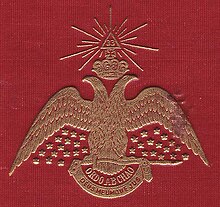 Morals and Dogma by Pike and the Scottish Rites The first mention of a double-headed eagle in the West dates from 1250, in a roll of arms of Matthew of Paris for Emperor Frederick II of the Holy Roman Empire. Usually depicted black on a gold background, it replaced the earlier single-headed eagle, and was subsequently adopted in the coats of arms of many German cities and aristocratic families. After the dissolution of the Holy Roman Empire in 1806, the double-headed eagle was retained by the Austrian Empire, and served also as the coat of arms of the German Confederation. The double-headed eagle was part of the emblem of the Order of the Solar Temple. This cult was started by Joseph Di Mambro and Luc Jouret in 1984 in Geneva. It gained notoriety in 1994 when members of the cult committed mass suicide and murders in two villages in Switzerland, followed in 1997 by suicide/murders in Canada. http://en.wikipedia.org/wiki/Double-headed_eagleThe Greek Orthodox chapel has a circle floor with a sun and wavy rays coming from itthere is a rock there which the crack goes down to the chapel of Adam belowit is said that Jesus blood dripped down to reach the skull of AdamMagdalen's star has points and a green stone center http://www.sacred-destinations.com/israel/jerusalem-holy-sepulchre-photos/slides/franciscan-mass-cc-irithThe Franciscans he impact of the Franciscan Third Order Secular upon the feudal society of medieval Europe has been held to be considerable. Among its ways of impacting that era was the prohibition on the brothers of the Order from bearing arms. This stance of pacifism in a society with frequent feuds and wars was upheld by the authority of the Church, and limited the ability of the nobility and towns to demand that all men be subject to serving in battle. Also, the admission to the Order of members from all stations in life on an equal basis was a mechanism for promoting social change in a period of rigid social stratification. The Third Order has known many notables among its members. Outstanding among them is Saint Elisabeth of Hungary, though it is not established to all that she ever formally joined;[3] she is, however, Patroness of the Order. Additionally, she is traditionally paired with St. Louis, King of France, declared Patron of the Order. Among other notable figures were: St. Ferdinand, King of Castile; St. Elizabeth of Portugal, grand-niece of the first St. Elizabeth; St. Rosa of Viterbo; St. Margaret of Cortona; St. Thomas More; Blessed Umiliana Cerchi; Blessed Angela of Foligno; St. Ivo of Kermartin; Saint John Vianney, the famed Curé of Ars, France. Of names celebrated in history for literature, arts, politics, inventions, etc., Blessed Raymond Lull; Dante, Giotto, Petrarch, Cola di Rienzo, Christopher Columbus, Vasco da Gama, Cervantes, Lope de Vega, Galvani, Alessandro Volta, Garcia Moreno, Franz Liszt, and Lady Georgiana Fullerton. Popes Pius IX and Leo XIII were members of the Third Order, as also were Pope St. Pius X and the Blessed Pope John XXIII The Third Order of Saint Francis Canada The Third Order of St. Francis was established by the Friars Minor Recollects at Quebec in 1671, and some years later at Three Rivers and Montreal. Considering the sparse population of the country, it was in a flourishing condition. In 1681 a Recollect notes that "many pious people of Quebec belong to the Third Order". After the cession of Canada to England, the Third Order, deprived of its directors, the Recollect Franciscan friars, seemed to have disappeared gradually, only to flourish anew thirty years after the death at Montreal in 1813 of the last Recollect friar. The Third Order was re-established about 1840 by Mgr. Ignatius Bourget, Bishop of Montreal. Fervent fellow-labourers helped the holy prelate to spread the Third Order in Montreal, notably Canon J.A. Paré and the Sulpicians C. E. Gilbert and A. Giband. Mgr. Bourget established a fraternity of women, 6 May 1863, and one of men, 13 June 1866; both were directed by the Sulpicians till 1874, by Canon P. E. Dufresne from 1874 till 1881, by the Jesuits from 1881 till 1888, and by the Sulpicians from 1888 till 1890; since then by the Friars Minor. Mgr. Fabre, successor to Bishop Bourget, in a letter (3 September 1882) to the priests and faithful of his diocese, says: "We have in our midst the tertiaries of St. Francis, who are known to you all by the edification they give, and by the good odour of all the virtues which they practise in the world." The Third Order was reintroduced at Quebec almost at the same time as at Montreal. On 19 November 1859, Father Flavian Durocher, O.M.I., received the profession of two women, after a year's novitiate. These were joined by others, until in 1876 Quebec City alone possessed over 200 tertiaries, while in the Province of Quebec several parishes had groups of tertiaries. Saint Francis of Assisi rejected the urban materialism of his parents and local church. He established a mendicant, or beggar, lifestyle for the followers of his church-approved order—Franciscan friars for men and the Poor Clares for women. Many religious thinkers in the 1200s were influenced by the earlier philosophy of Christian Neoplatonism, a synthesis of Plato’s ideals and Christian mysticism. Under that influence, they rejected the Aristotelian focus on rationalizing religion and believed God's divine revelation could best be understood through experience. The Cistercian Bernard of Clairvaux, who died in 1153, feared that Abelard's scholastic logic would deaden true spiritual understanding. Later, Bonaventure, a Franciscan who lived from 1221 to 1274, developed a mystical philosophy guiding Christians toward contemplation of the ideal realm of God. http://history-world.org/dynamic_culture_of_medieval_euro.htmAlexander of Hales, Bonaventure, and John Duns Scotus, the "Doctor of Wonders" Roger Bacon, and the well-known mystic authors and popular preachers David of Augsburg and Berthold of Regensburg. as well as Anthony of Padua
|
|
|
|
|
The Druids had a Solar Wheel 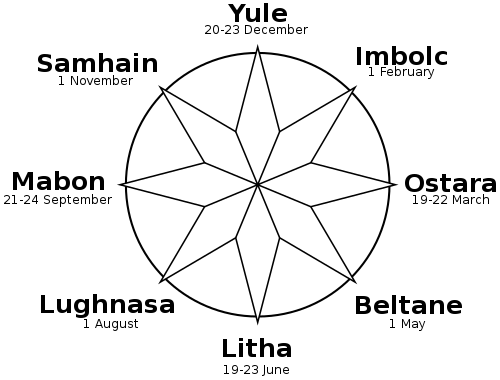 Druids had a Jewish connection the floors of the Holy Sepulcher may reflect the solar wheel Rennes Chateau is illuminated by the stained glass showing the Sun King and the Magdalene Halo shines on the floor  At the Holy Sepulcher there are two circular star patterns on the marble floors one for Christ ....a sun with wavy lines the Magdalene star is the straight lines similar to a compass 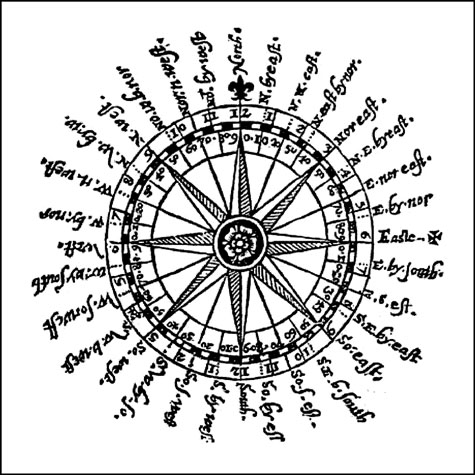 The Crusaders building the Holy Sepulchre had a understanding of the stars and the ending of the Pisces Age and the coming of the Water Bearer....Magdalene with her tears and her vase may reflect the Age of WOMEN
_________________
Everything is Connected and there are no
coincidences |
|
|
|
|
|
Santo Sepulcro

Planta del edificio durante el siglo XIX.

Bóveda del Catolicon con la imagen de Jesús.
El Santo Sepulcro es un sitio religioso relacionado especialmente con el Cristianismo, particularmente católicos y ortodoxos. El lugar, llamado también Gólgota (en arameo, Golgotha, 'calavera') es donde-según los Evangelios- se produjo la Crucifixión, enterramiento y Resurrección de Cristo. Está ubicado dentro de la Ciudad Vieja de Jerusalén, la cual a su vez se ubica en la línea de confluencia entre la Jerusalén oriental (árabe) y occidental (judía).
A la basílica del Santo Sepulcro de Jerusalén también se la conoce como la Basílica de la Resurrección (Griego: Ναός της Αναστάσεως, Naós tis Anastáseos; Georgiano: Agdgomis Tadzari; Armenio: Surp Harutyun) o de la Anástasis (en griego, 'Resurrección').
Esta basílica, uno de los centros más sagrados del Cristianismo, ha sido un importante centro de peregrinación desde el siglo IV.
Hoy día alberga la sede del Patriarca Ortodoxo de Jerusalén y es la catedral del Patriarcado Latino de Jerusalén.
[editar] Determinación
En general, cuando hablamos del Santo Sepulcro, podemos distinguir dos cosas:
- La iglesia de Jerusalén en la que se encuentran el sepulcro de Jesús, el monte Calvario (donde murió), la piedra donde fue ungido antes de ser sepultado y el aljibe donde fue encontrada su cruz cuatro siglos más tarde. Secundariamente alberga diversas capillas. Entre ellas destaca la capilla de Santa Elena, el coro de los Griegos y la capilla del Santísimo (de los franciscanos, custodios de Tierra Santa), la capilla de Longinos, y otras más.
- El sepulcro de Jesús (que se encuentra dentro de aquella iglesia).
El lugar hace referencia histórica[cita requerida] a la sepultura de Jesús en una época comprendida entre el año 30 y 33.[cita requerida] Entre los sitios religiosos de Tierra Santa, el Santo Sepulcro es uno de los mejor datados[cita requerida] históricamente.
[editar] Significado religioso
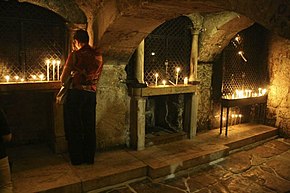
En este lugar encarcelaron a Jesús.
El significado religioso dado al Santo Sepulcro dentro del Cristianismo es importantísimo, pues dentro de este recinto se encuentra tanto el Calvario, donde Jesucristo murió, como su sepulcro, lugar en el que, según afirman los Evangelios, resucitó al tercer día de su muerte. Por esta razón el sepulcro es el centro principal de la basílica. La capilla que lo contiene, en medio de la llamada «Rotonda» al frente del coro de los Griegos, es conocida como la ἀνάστασις (que en griego significa 'resurrección').
Según los evangelios, antes de la muerte de Jesús el sitio era una tumba ya habilitada como tal, pero no utilizada todavía, propiedad de un rico judío seguidor de Cristo llamado José de Arimatea. Se trataría de un hueco horadado en la roca, que podía taparse con una gran piedra destinada al efecto para que rodara o se deslizara hasta la abertura del nicho.
Una de las versiones sobre el primer anuncio de la Resurrección de Cristo, según los Evangelios, es el momento en que las mujeres que iban a ungir su cadáver con especias aromáticas —María Magdalena, María de Cleofás, madre de Santiago el Menor y Judas Tadeo, y Salomé (discípula), madre de Santiago y Juan— se encontraron con la piedra desplazada, y el nicho expuesto y vacío.
Siempre teniendo como única fuente los Evangelios, pero confirmados por los trabajos arqueológicos[cita requerida], la tumba estaría situada en un jardín próximo a la roca —o montaña, o montículo; los evangelios dicen lugar— donde se produjo la Crucifixión, llamado originalmente Gólgota y luego Calvario (lat. calvaria, calavera), o en griego kranion (cráneo). Ese lugar estaba muy próximo a la muralla herodiana de la ciudad de Jerusalén, e incluso comunicado con ella por una calle, pero extramuros, ya que las normas judías prohibían los enterramientos intramuros, salvo para el caso de los reyes.
La destrucción de Jerusalén efectuada por los romanos trajo la ruina para el Templo de Jerusalén y para otros lugares tradicionales de la antigua ciudad puesta entonces bajo el mando de los paganos. Si bien los primeros cristianos huyeron hacia Petra antes de la destrucción siguiendo una interpretación profética de Jesús (Lucas 21, 20-22), los mismos dejaron por escrito en los Evangelios la descripción del lugar de la Crucifixión y de la sepultura: Mateo 27, 33; 57 - 61; Marcos 15, 22; 42 - 47; Lucas 23, 33; 50 - 55; Juan 19, 17; 38 - 42. Ambos sitios, el Gólgota y la Tumba, están a pocos metros de distancia y entre ellos se encuentra la Piedra de la Deposición, lugar en donde dice la tradición el cuerpo de Jesús fue preparado después de ser bajado de la cruz para ser enterrado - Mateo 27, 59 y paralelos -. El lugar fue evidentemente una cantera por la enorme riqueza lítica y la red de cavernas que se pueden observar[cita requerida], un sitio ideal para la construcción de tumbas, una actividad muy normal en la época, especialmente entre personas de cierta posición social. El nombre, «Gólgota», la «Calavera», viene probablemente de la semejanza que las formas que las rocas tenían, como se puede comprobar hoy por hoy en los paisajes desérticos del Mar Muerto. Los romanos cambiaron el nombre de Jerusalén por el de Aelia Capitolina con el fin de hacer de la ciudad un enclave exclusivamente greco-romano - prohibieron el ingreso de los pueblos semitas - y construyeron lugares de culto pagano en donde estaba el Templo de Jerusalén y el Santo Sepulcro. Dicho acontecimiento es una de las pruebas históricas y arqueológicas que evidencian la historicidad de ambos sitios. En cuanto al Santo Sepulcro, en el año 326, el Emperador Constantino mandó erigir la Basílica del Santo Sepulcro en el lugar prescrito por la tradición y en el cual estaba erigido el culto pagano a la diosa romana Venus, mandado construir por Adriano, hacia el 135.
La Emperatriz Elena había acudido a la ciudad tras escuchar el informe presentado por Macario, obispo de Jerusalén, sobre el lamentable estado en el que se encontraban los lugares descritos en los evangelios (santos lugares, para los cristianos), decidida a mejorar personalmente la situación. Tenía también el propósito de localizar la cruz de la ejecución de Jesús; Constantino había empezado a utilizar el signo de la cruz, y a considerarlo presagio de victoria.
Elena, tras fracasar en la búsqueda de la cruz, o como parte de ella, inició la del sepulcro. La tradición cuenta que al derruir el templo pagano para aislar el Calvario e iniciar las nuevas edificaciones aparecieron también tres cruces, una de las cuales necesariamente habría[cita requerida] de ser la Vera Cruz o auténtica cruz del martirio de Cristo. Varias leyendas describen el prodigio que permitió identificar la Vera Cruz, casi siempre basadas en que una de las cruces producía curaciones milagrosas, y las otras dos no.
Los sucesos descritos a partir de 325-326, sobre el descubrimiento del sepulcro y la Vera Cruz por la Emperatriz Elena, se deben al obispo de Cesarea (Palestina) e historiador Eusebio, llamado también el Padre de la historia de la Iglesia.

Planta del edificio durante el siglo IV.
|
|
|
|
|
(k) Chapel of Mary Magdalene:
| |
On the north side of the Rotunda, the hall of the tomb, is the Franciscan Chapel of Mary Magdalene. Mary of Magdala (Migdal) accompanied Jesus on his way to the cross and burial (Mark 15, 47: "And Mary Magdalene and Mary the mother of Jesus beheld where he was laid") .
The plan of the church is seen on the right, with the location of the Chapel marked by a red marker on the north-western side of the church, adjacent to the Rotunda.
|
|
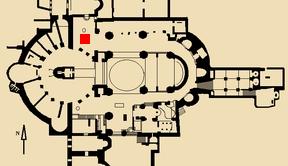 |
The altar is on the left side (shown on the next picture), while the Rotunda is seen in the background. On the north side of the chapel are more rooms.
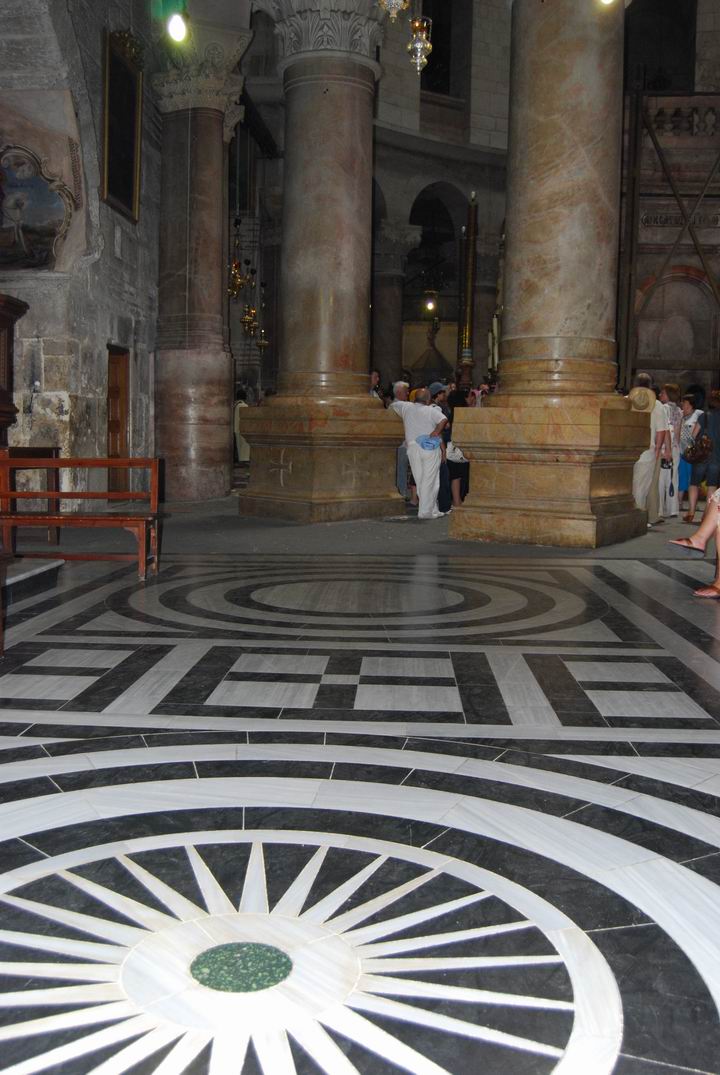
A view of Mary Magdalene is seen in the photo below.

(l) Greek Orthodox chapel - Prison of Jesus:
| |
On the North-Eastern side of the Church, walking around the northern ambulatory, is a Greek Orthodox chapel of the Prison of Jesus.
See plan of the church on the right; the location is marked by a red marker on the north-eastern corner of the church.
|
|
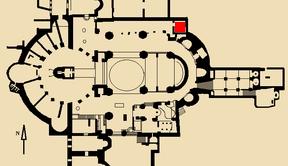 |
A view of the chapel at the end of the northern walls is seen below. According to tradition, Jesus and the two thieves were housed here before the crucifixion.
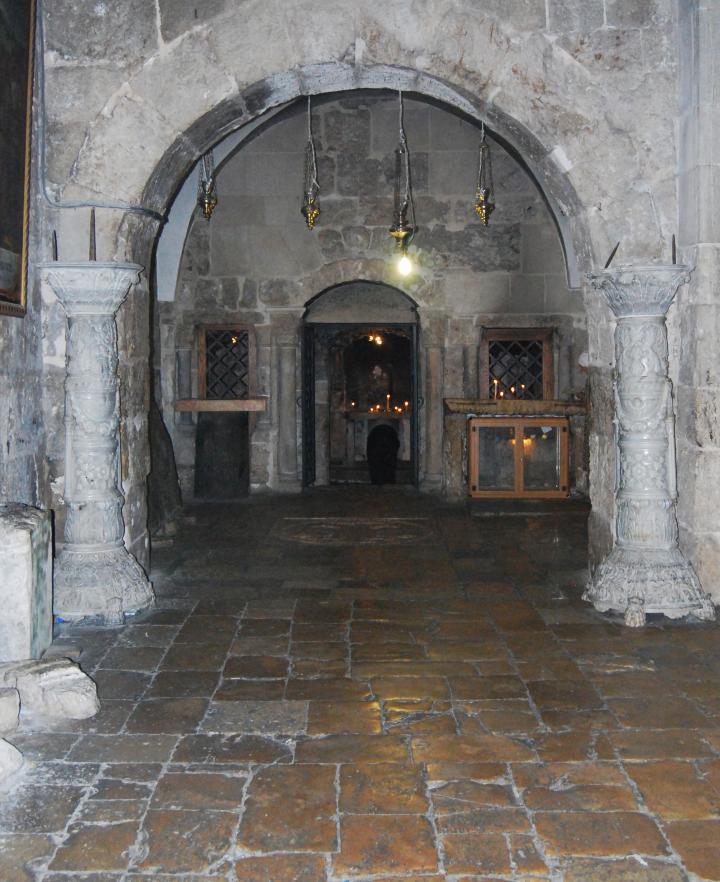
On the floor, in front of the chapel, is a mosaic figure of a double headed eagle - symbol of the Byzantine empire and the Greek Orthodox church.

Before the entrance to the Prison of Jesus is a smaller chapel of the handcuffs of Jesus, seen on the right side.
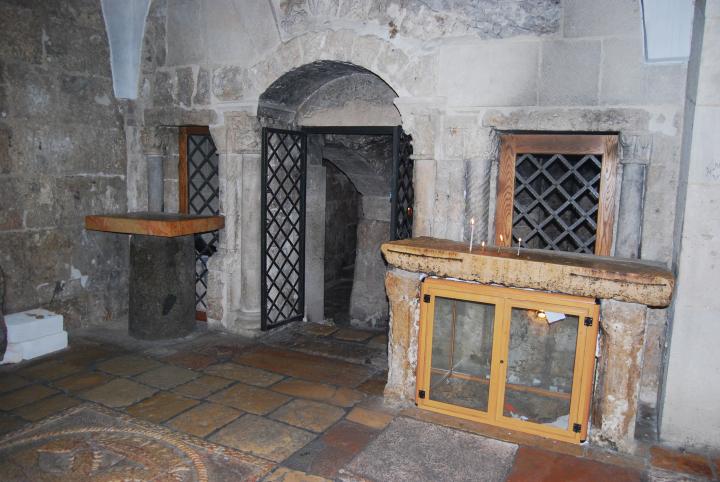
Under the altar, behind a glass window, are two holes in the floor. According to tradition, these holes (seen below) are the imprints of the feet of Jesus. Pilgrims leave notes inside the window.
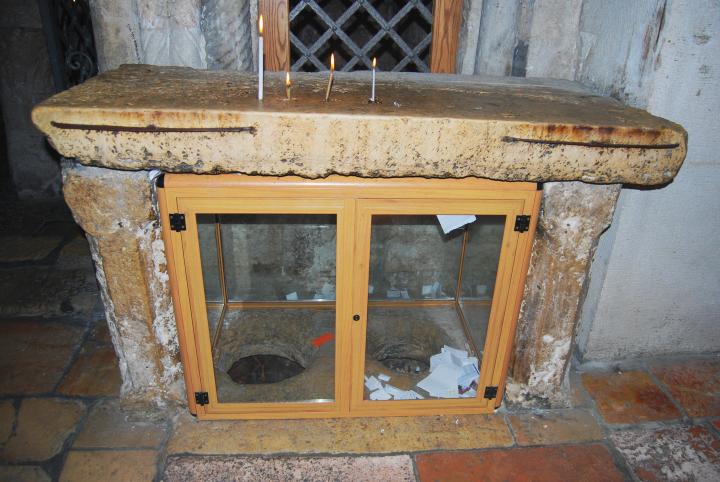
Inside the inner room is the chapel of Prison of Jesus.
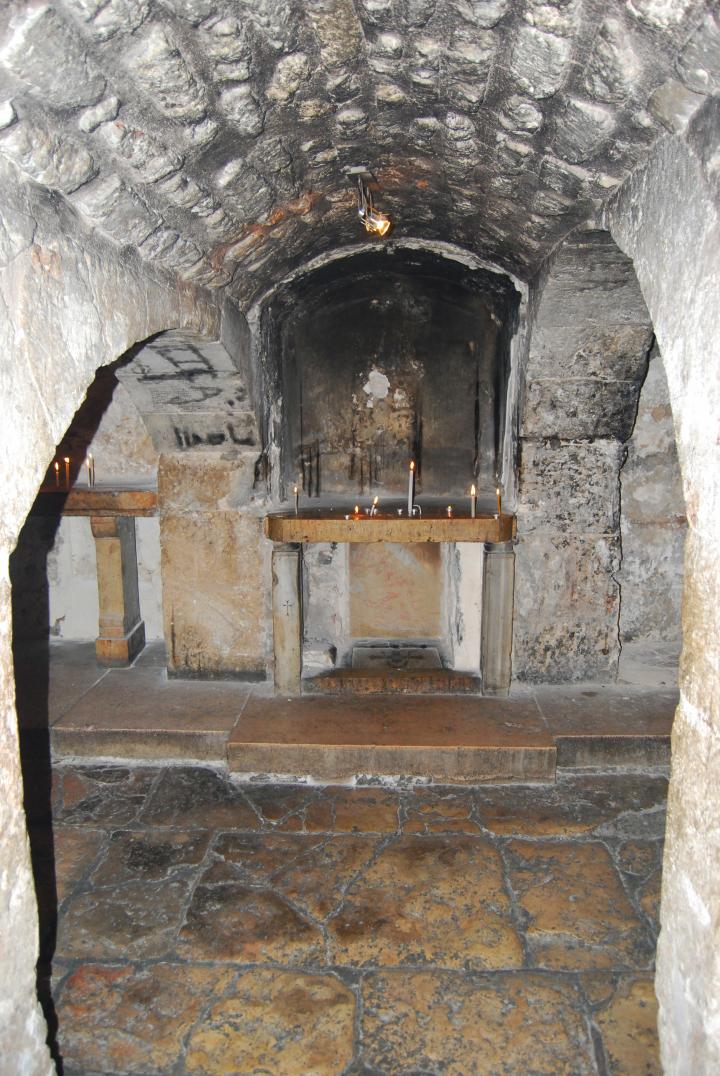
A closer view of the altar is seen below. Pilgrims, who come to pray here, light up candles which leave black smoke marks on the walls.
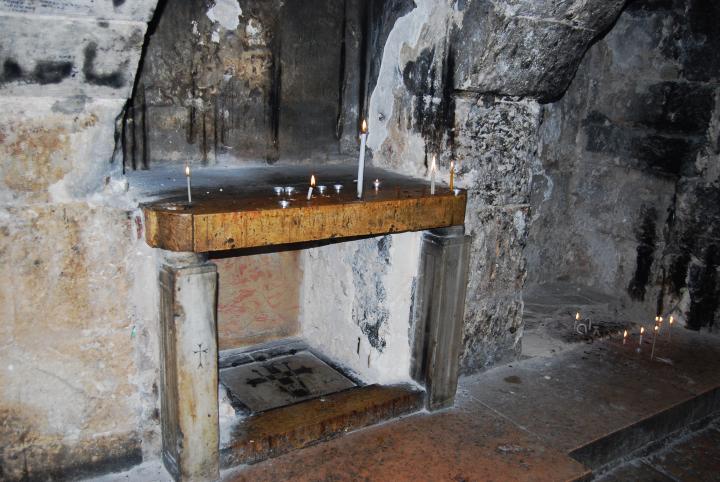
http://www.biblewalks.com/Sites/Sepulcher.html |
|
|
|
|
On the floor, in front of the Holy Sepulchre, is a mosaic figure of a double headed eagle - symbol of the Byzantine empire and the Greek Orthodox church.
|
|
|
|
|
Haz hecho público que te gusta. Deshacer
Haz hecho público que te gusta. Deshacer25 publicaciones - 5 autores - 23 Ene.
Crop circles usually are found in England but the past two years ..... in front of the Holy Sepulchre, is a mosaic figure of a double headed eagle ...
www.gabitogrupos.com/DESENMASCARANDO.../template.php?...En caché
Haz hecho público que te gusta. Deshacer
Haz hecho público que te gusta. Deshacer8 publicaciones - 5 autores - 4 Abr. 2010
Worshipers gathered at the Church of the Holy Sepulchre in ... On the floor, in front of the chapel, is a mosaic figure of a double headed eagle ...
Haz hecho público que te gusta. Deshacer
Haz hecho público que te gusta. Deshacer
[PDF]
Haz hecho público que te gusta. Deshacer PDF/Adobe Acrobat - Vista rápidaThe origin of the mosaic's imagery will be discussed in Chapter Two, with the goal of ..... Directly above Peter's head is the octagonal end of the ... Figure 14: Illustration of the Church of the Holy Sepulcher, the Madaba Map, sixth ... angel of St. Matthew, the winged lion of St. Mark, the winged bull of St. Luke, and the eagle of ...
https://picasaweb.google.com/.../RMty0zglNbzmmHRcOuJ- ...En caché
Haz hecho público que te gusta. Deshacer
Haz hecho público que te gusta. Deshacer
Haz hecho público que te gusta. Deshacer
|
|
|
 Primer
Primer
 Anterior
2 a 12 de 42
Siguiente
Anterior
2 a 12 de 42
Siguiente Último
Último
|

